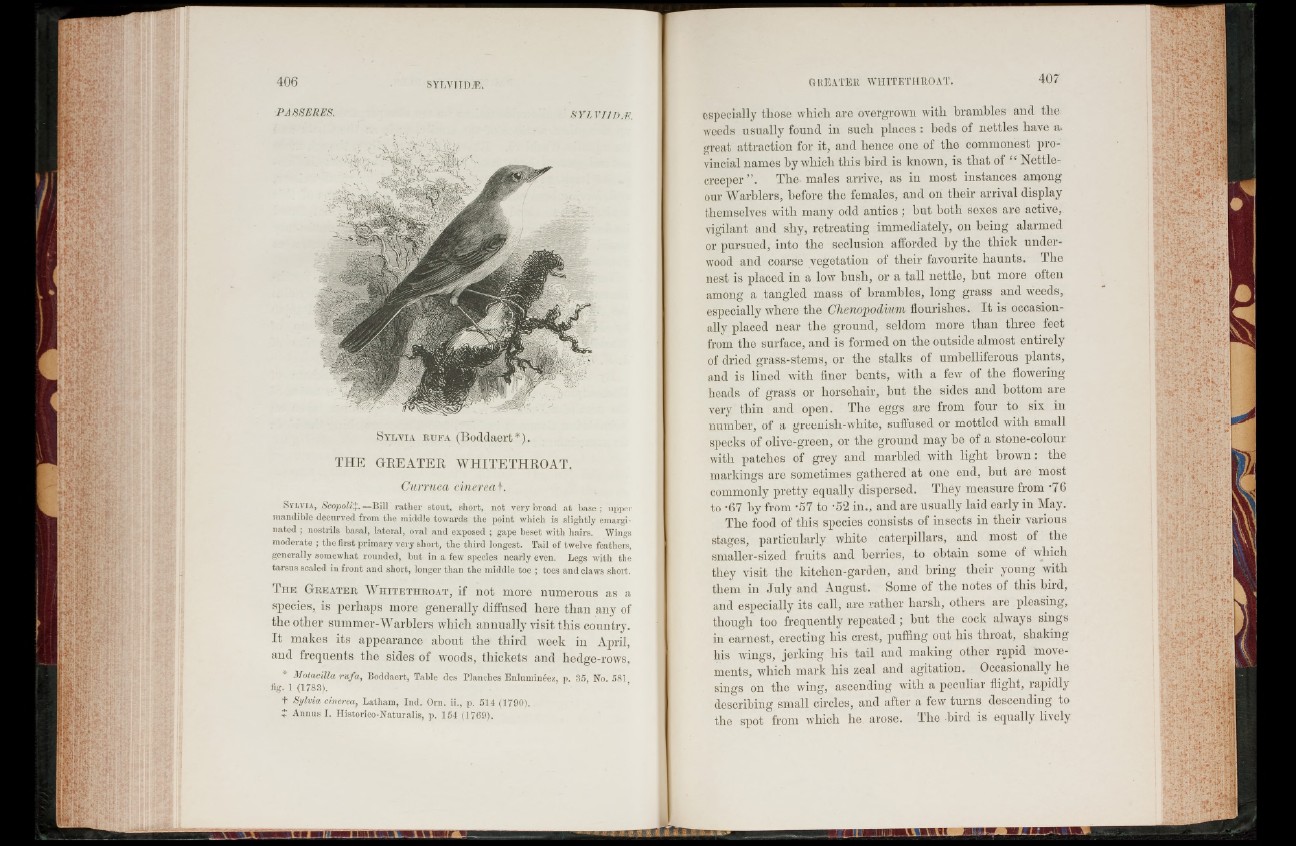
P A S SE RES. s y iv u d m . especially those which are overgrown with brambles and the
S ylv ia k u fa (Boddaert*).
THE GREATER WHITETHROAT.
Curruca cinerea\.
S y l v ia , Scopoli%.—Bill rather stout, short, not very hroad at base ; upper
mandible decurved from the middle towards the point which is slightly emargi-
nated ; nostrils basal, lateral, oval and exposed ; gape beset with hairs. Wings
moderate ; the first primary very short, the third longest. Tail of twelve feathers,
generally somewhat rounded, but in a few species nearly even. Legs with the
tarsus scaled in front and short, longer than the middle toe ; toes and claws short.
T h e G r e a t e r W h it e t h r o a t , if not more numerous as a
species, is perhaps more generally diffused here than any of
the other summer-Warblers which annually visit this country.
It makes its appearance about the third week in April,
and frequents the sides of woods, thickets and hedge-rows,
Motacilla rufa, Boddaert, Table des Planches Enlumineez, p. 35, No. 581
fig. 1 (1783).
t Sylvia cinerea, Latham, Ind. Orn. ii., p. 514 (1790).
J Annus I. Historieo-Naturalis, p. 154 (1769).
weeds usually found in such places : beds of nettles have a.
great attraction for it, and hence one of the commonest provincial
names by which this bird is known, is that of “ Nettle-
creeper” . The males arrive, as in most instances among
our Warblers, before the females, and on their arrival display
themselves with many odd antics ; but both sexes are active,
vigilant and shy, retreating immediately, 011 being alarmed
or pursued, into the seclusion afforded by the thick underwood
and coarse vegetation of their favourite haunts. The
nest is placed in a low bush, or a tall nettle, but more often
among a tangled mass of brambles, long grass and weeds,
especially where the Chenopodium flourishes. I t is occasionally
placed near the ground, seldom more than three feet
from the surface, and is formed on the outside almost entirely
of dried grass-stems, or the stalks of umbelliferous plants,
and is lined with finer bents, with a few of the flowering
heads of grass or horsehair, but the sides and bottom are
very thin and open. The eggs are from four to six in
number, of a greenish-white, suffused or mottled with small
specks of olive-green, or the ground may be of a stone-colour
with patches of grey and marbled with light brown: the
markings are sometimes gathered at one end, but are most
commonly pretty equally dispersed. They measure from '76
to -67 by from -57 to -52 in., and are usually laid early in May.
The food of this species consists of insects in their various
stages, particularly white caterpillars, and most of the
smaller-sized fruits and berries, to obtain some of which
they visit the kitchen-garden, and bring their young with
them in July and August. Some of the notes of this biid,
and especially its call, are rather harsh, others are pleasing,
though too frequently repeated; but the cock always sings
in earnest, erecting his crest, puffing out his throat, shaking
his wings, jerking his tail and making other rapid movements,
which mark his zeal and agitation. Occasionally he
sings on the wing, ascending with a peculiar flight, lapidly
describing small circles, and after a few turns descending to
the spot from which he arose. The bird is equally lively